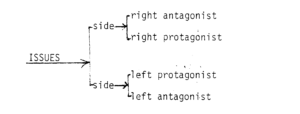Martin, J. R. (1986). Grammaticalising ecology: The politics of baby seals and kangaroos. In T. Threadgold, E. A. Grosz, G. Kress, & M. A. Halliday (Eds.), Language, Semiotics, Ideology. (Vol. 3). Sydney: Sydney Association for Studies in Society and Culture.
In “Grammaticalising Ecology,” Martin argues a fourth level of ideology needs to be added to SFL’s three-tiered, multi-stratal model of language. Unlike denotative semiotic systems such as music, where there is a one-to-one correspondence between meaning and expression, Martin (1986) believes connotative semiotic systems are parasitic—”they don’t have a phonology of their own; instead they take over another semiotic system as their expression form” (p. 226). In this model, language serves as the expression of register (the context of situation made up of field, tenor, and mode variables); register serves as the expression of genre (the context of culture made up of register patterns); and genre serves as the expression of ideology (p. 226). However, these patterns of meaning can cut across various levels, as ideology can be encoded in lexis (wording), for instance, calling a crowd a mob or riot. Martin argues that without theorizing a plane of ideology it is difficult to predict why certain groups choose different genres for communication, and it is also difficult to predict how genres will be realized in specific contexts. A looming question regarding ideology is the role of access in terms of what social groups have access to what meanings.
In the article Martin provides a model for mapping the ideological positions of different social groups in terms of their stances towards political issues. Martin (1984) believes it is useful to look at disputes as “ideology in crisis”: “When ideology is in crisis, the linguistic choices reflecting one or another stance are foregrounded” (p. 228). Martin’s model for ideology in crisis begins with a particular issue. Issues have two sides, pro and con. On each side there are antagonists, those concerned with stirring up an issue, and protagonists, those concerned with resolving disputes in an effort to maintain the power of the dominant group. The full model divides issues into Right and Left sides, the Right concerned with maintaining power and the Left concerned with gaining power, each side also containing antagonist and protagonist roles (see Figure 1.).

Figure 1. Issues as ideological systems
Martin uses this model of ideological systems to analyze two texts. The first text, from Habitat: A Magazine of Conservation and Environment, discusses whether Australia should kill kangaroos for population control, while the second text, taken from International Wildlife: Dedicated to the Wise Use of Earth’s Resource’s, discusses whether Canada should continue to hunt baby seals. As a magazine dedicated to environmental activism, Habitat could be said to be on the political Left, while International Wildlife, dedicated to more “conservative” forms of conservation, is on the Right. Both texts use different genres to achieve their social purpose. Text 1 is an example of a hortatory genre to provoke a call to action. In terms of register, text 1 uses more dramatic lexis, using words like killing and murdering to convey the injustice of slaughtering kangaroos. Text 2, on the other hand, is expository and analytical, concerned with preserving power. Text 2 is less emotional, using words like population control and wildlife management, positing seals as a natural resource to be controlled responsibly.
While the modeling of ideological systems is still in its early stages, Martin does raise several questions related to meaning, texts, and ideology. What ideologies and range of meanings do different social groups draw from? How can social groups “stir up” and resolve ideological conflicts through discourse? How do social groups mischaracterize and attack their opposition intertextually?
I will be able to draw from Martin’s work by applying this linguistic model to the realm of images. This model will be useful in analyzing the “meme wars” of our current political climate. Martin’s approach provides a tangible method for beginning to understand the complex relations visual rhetoric has to design, text, intertextuality, power, and social context. By mapping an ideological plane of visual rhetoric, rhetoricians have more systematic tools for understanding the gendering of discourses, as well as the unequal distribution of access to genres in terms of social power.
